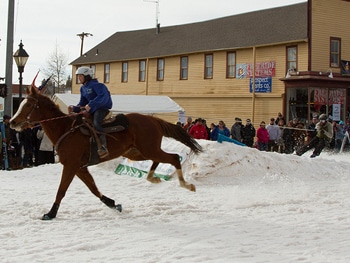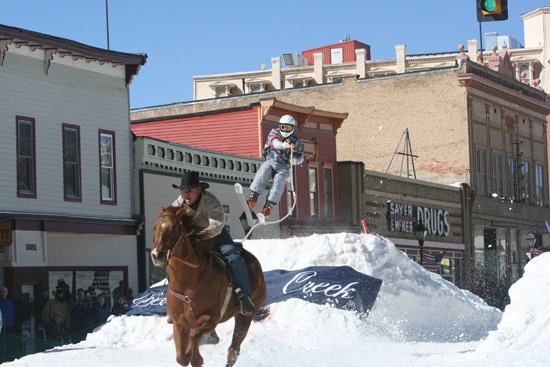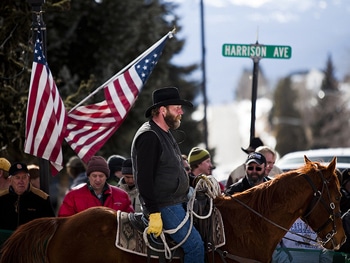When I think of equestrian events at the Olympic Games I think of dressage and show jumping – you know – the Summer Olympics. Did you know there used to be a winter equestrian sporting event? It’s called skijoring and in 1928 it was a demonstration sport in the 2nd modern Winter Olympics!
1. In what century was skijoring a demonstration sport in the Winter Olympics?
2. How many years ago was skijoring a a demonstration sport in the Winter Olympics?
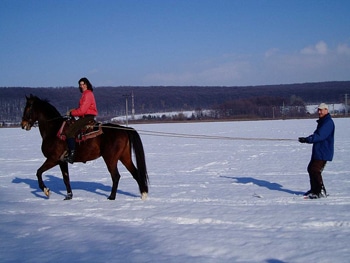
Leadville, Colorado held the first North American skijoring race in 1949.
3. How many years ago did the first skijoring race take place in North America?
Two types of race courses are common in skijoring competitions, the straight course and the horseshoe-shaped course. The straight course allows the horse to run at top speed down the middle of the course with the skier navigating slalom gates and jumps ranging from three to nine feet high, set on either side of the horse track.
At some events, to add difficulty, the skier is also required to grab one or more rings as they ski past a station on the course. The horseshoe-shaped course allows the horse to run on the inside of the track while the skier navigates slalom racing gates and jumps ranging from four to six feet high.
The World Skijoring Championships have been held in Whitefish, Montana since 2009, as a part of the annual Whitefish Winter Carnival, usually the last weekend of January. This year’s event was just last week and the results are in!
The length of the course is approximately 750 to 800 feet. One of the rules is that a horse or mule (yes, there is a mule class) cannot run more than twice a day.
4. Assuming a course distance of 750 feet, how far would a horse run if it ran the course twice? Express your answer in yards.
5. Assuming a course distance of 800 feet, how far would a horse run if it ran the course twice? Express the number of feet in word form.
Ropes are to be 50ft in length and 3/8” or larger in diameter. Handles on ropes are not permitted.
Math Talk – diameter: a straight line passing through the centre of a circle to touch both sides of the circumference. In the sentence above it is referring to the thickness of the rope.
While skijoring is a timed event, penalty points are given for missed elements on the course. At the Whitefish world championship event, penalties are received for the following:
- A five second penalty is assessed for each missed jump or gate.
- A five second penalty is assessed for any horse breaking the plane of any jump, hitting a gate, or hitting a timing device (i.e. clapper boards).
There are also different classes or divisions.
-
OPEN CLASS teams are considered to be the highest skilled competitors with the fastest horses. A team consists of horse, rider and skier.
- SPORT CLASS teams are considered to be intermediate level skill participants riding horses that may not be fast enough to be in the open class.
- NOVICE CLASS teams are considered to be beginning level competitors riding horses that may not have speed enough to be competitive in the open or the sport class. Any horse that wins 1st place in this class must move to a higher level of competition for the following year at the Whitefish event.
- MULE CLASS – a mule is a cross between cross between a female horse and a male donkey.
This year, the winner of the Novice class was the team of Emily Lewis (skier), Barton Slaney (rider) and Belle (the horse). They finished with a time of 0:16.94 seconds.
6. Express their time in word form.
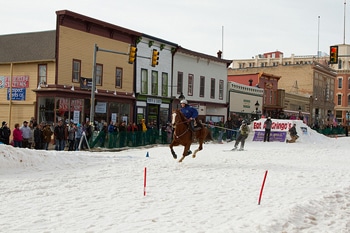
7. Express their time in word form.
8. How much faster was the winning team from the Novice division than the winning team from the Mule division?
The Sport division was won by the team of Tim O’Brien (skier), with Molly Fisher riding Jane. Their time was 0:16.71.
9. How much faster did they finish than the winners of the Novice Division?
The Open division was won by Toby McIntosh (skier), Joe Scanlon (rider) and Mud D Duck with a time of 0:15.50.
The second place team in this division was Toby McIntosh (skier), Tim Guest (rider) and Couger. They finished with a time of 0:15.60.
10. How much faster was the first place team than the second place team? Express the time in word form.
After all those math questions why not take a break before checking your answers and watch a little live action!
Winter Equestrian Sport – Skijoring Answers:
1. In what century was skijoring a demonstration sport in the Winter Olympics?
Answer: Skijoring was a demonstration sport in the Winter Olympics in the 20th century.
2. How many years ago was skijoring a a demonstration sport in the Winter Olympics?
Answer: 2014 – 1928 = 86. Skijoring was a demonstration sport in the Winter Olympics 86 years ago.
3. How many years ago did the first skijoring race take place in North America?
Answer: 2014 – 1949 = 65. The first skijoring race to take place in North America was 65 years ago.
4. Assuming a course distance of 750 feet, how far would a horse run if it ran the course twice? Express your answer in yards.
Answer: Step 1: 750 x 2 = 1500.
Step 2: 1500 ÷ 3 = 500. A horse would run 500 yards.
5. Assuming a course distance of 800 feet, how far would a horse run if it ran the course twice? Express the number of feet in word form.
Answer: 800 x 2 = 1600. A horse would run one thousand and six hundred feet.
6. Express their time in word form.
Answer: 0:16.94 is read as sixteen and ninety-four hundredths of a second.
7. Express their time in word form.
Answer: Twenty and twenty-seven hundredths of a second.
8. How much faster was the winning team from the Novice division than the winning team from the Mule division?
Answer: 20.27 – 16.94 = 3.33. The winning team from the Novice division was 3.33 seconds faster than the winning team from the Mule division.
9. How much faster did they finish than the winners of the Novice Division?
Answer: 16.94 – 16.71 = .23. They finished .23 seconds faster than the winners of the Novice Division.
10. How much faster was the first place team than the second place team? Express the time in word form.
Answer: 15.60 – 15.50 = .10 (Were you able to do that one in your head?) The first place team was one tenth of a second faster than the second place team.
Common Core:
4.OA.A.2 – Addition, subtraction, multiplication, and division word problems
4.NBT.B.5 – Multiply a whole number of up to four digits by a one-digit whole number
4.NF.C.7 – Compare two decimals to hundredths by reasoning about their size
4.MD.A – Solve problems involving measurement and conversion of measurements
5.NBT.A Understand the place value system.
5.NBT.B.7 Add, subtract, multiply, and divide decimals to hundredths
5.MD.A – Convert like measurement units within a given measurement system
Photos:
Skijoring Mirror Lake, source: New England Ski Museum; CC BY-SA 3.0
Skijoring by Otm; public domain
Leadville Ski-joring by mt2ri; CC BY-SA 2.0
A Leadville Ski Joring team by Kaila Angello; CC BY-SA 3.0
Modern day cowboy by Menno Abbink; CC BY 2.0
Leadville Ski-joring by mt2ri; CC BY-SA 2.0



